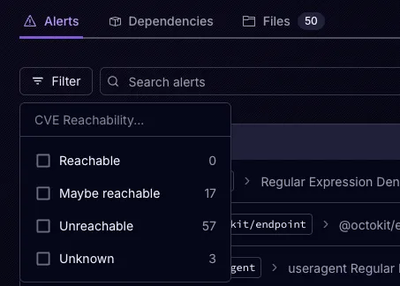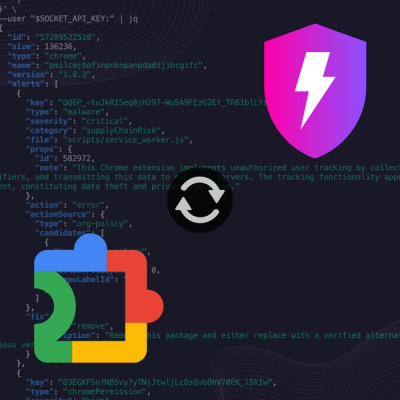
Product
Announcing Precomputed Reachability Analysis in Socket
Socket’s precomputed reachability slashes false positives by flagging up to 80% of vulnerabilities as irrelevant, with no setup and instant results.
eslint-nibble
Advanced tools
Sometimes running ESLint against an existing project and fixing the hundreds or thousands of errors is biting off more than you can chew.
Instead, eslint-nibble will give a quick overview of your failing rules, and then show the detailed error reports for one rule at a time.
If a rule can be automatically fixed by ESLint, eslint-nibble will allow you to run autofix on individual rules, allowing you to make more focused commits.
Read this excellent blog post from Paul Hands for a clear explanation of what eslint-nibble can do for your project: Hiring a gardener to trim the weeds.
npm install --no-save eslint-nibble
You can also install eslint-nibble globally, but it is not recommended.
Instead, try installing eslint-nibble in your project with --no-save (as shown above), because this tool is intended only to get you up and running. Once you're happy with your rules and your code, you can remove eslint-nibble.
Note: as of version 5.0.0, eslint-nibble no longer comes with its own bundled version of eslint. Instead, you should install eslint into your project (see getting started), and eslint-nibble will use the version you install.
This module does not make any decisions about which ESLint rules to run. Make sure your project has an .eslintrc file if you want ESLint to do anything. No linting rules are enabled by default.
There are a few methods you can use to run eslint-nibble, depending on the package manager you are using.
If you're using npm@5.2.0 or later, you can simply run:
npx eslint-nibble <directories and files to lint>
Similarly, if you are using yarn, you can run:
yarn eslint-nibble <directories and files to lint>
Add something like the following to your package.json file:
"scripts": {
"nibble": "eslint-nibble <directories and files to lint>"
}
Then, to run eslint-nibble, you can use:
npm run nibble
Eslint-nibble will then display a rundown of the rules that are failing and a summary of the results, using eslint-stats and eslint-summary, and will ask you to pick a rule to work on:

Select one of the rules by arrowing up/down and pressing enter.
If the rule can be fixed automatically, ESLint will ask if you'd like it to attempt perform fixes for you.
If there are lint warnings, you will also be asked whether you want those to be auto-fixed.

If you decide not to make autofixes, or the autofix completes but cannot fix all the errors, then a detailed list of the errors will be presented, using eslint-friendly-formatter.
If you are using iTerm2 or Guake, you can set them up so that your text editor opens to the correct line when you click on the filename.

--extIf your Javascript files have an extension other than .js, you can use the --ext flag to
specify which extensions to examine. For example, this will check all files ending in .jsx or .js:
eslint-nibble --ext .jsx,.js lib/
--config, -cESLint will automatically detect config files with standard naming.
Add the --config option to specify a different config file for ESLint to use.
--cacheHighly recommended. ESLint will cache the results of linting, causing subsequent runs to be much faster. See the ESLint docs for more details.
--cache-locationWhen used in conjunction with the --cache flag, controls where the ESLint cache
is written. See the ESLint docs
for more details.
--multiAllows selection of more than one rule at a time in the interactive cli.
--no-warningsOnly show results for linting errors, not warnings.
--ruleIf you have so many failing rules that navigating the list is cumbersome, use this flag to filter down
the rules that are displayed. Multiple rules can be included as comma-separated strings (e.g. --rule semi,quotes),
or by using multiple --rule flags (e.g. --rule semi --rule quotes).
--rulesdirThis corresponds to the eslint --rulesdir option. Use it to specify a path to custom eslint rules.
--no-interactivePotentially useful in CI, or any other situation where you would like to run ESLint using your standard project config (.eslintrc), but only on a subset of rules (using the --rule flag). Using --no-interactive will prevent eslint-nibble from displaying a menu, but will instead print out any warnings/errors and return an exit code of 1 if there are errors, or 0 otherwise, just like ESLint itself does.
--format, -fWhen used in conjunction with --no-interactive, controlls the output format from ESLint. Has no effect in interactive mode. The default ESLint formatter will be used if --format is not set.
You are not limited to directory and file names as arguments, you can also specify a glob pattern.
For example, to examine all *.jsx files in all test/ directories under lib/:
eslint-nibble lib/**/test/**/*.jsx
6.1.0
--rulesdir option to load custom rules at runtime (#76)FAQs
Ease into ESLint, by fixing one rule at a time
The npm package eslint-nibble receives a total of 55,564 weekly downloads. As such, eslint-nibble popularity was classified as popular.
We found that eslint-nibble demonstrated a healthy version release cadence and project activity because the last version was released less than a year ago. It has 1 open source maintainer collaborating on the project.
Did you know?

Socket for GitHub automatically highlights issues in each pull request and monitors the health of all your open source dependencies. Discover the contents of your packages and block harmful activity before you install or update your dependencies.

Product
Socket’s precomputed reachability slashes false positives by flagging up to 80% of vulnerabilities as irrelevant, with no setup and instant results.

Product
Socket is launching experimental protection for Chrome extensions, scanning for malware and risky permissions to prevent silent supply chain attacks.

Product
Add secure dependency scanning to Claude Desktop with Socket MCP, a one-click extension that keeps your coding conversations safe from malicious packages.